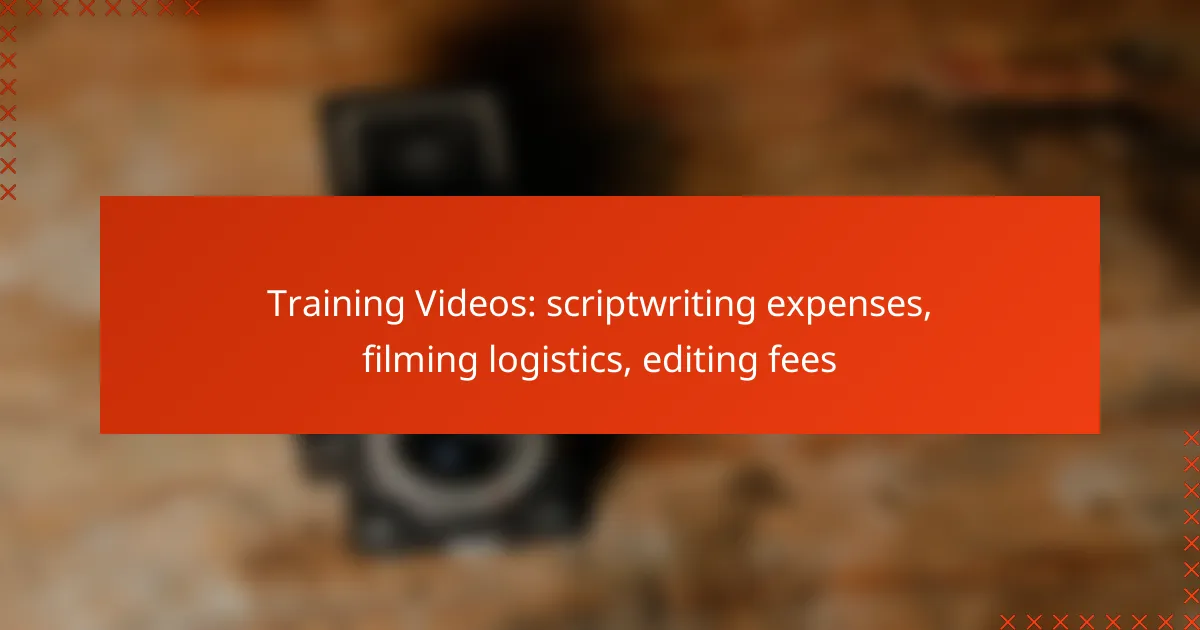Creating effective training videos involves several key expenses, including scriptwriting, filming logistics, and editing fees. Scriptwriting costs can vary based on content complexity, while filming logistics require meticulous planning to ensure smooth execution. Additionally, editing fees fluctuate depending on the project’s intricacy and the editor’s expertise, making it essential to budget accordingly for a polished final product.

What are the scriptwriting expenses for training videos?
Scriptwriting expenses for training videos can vary significantly based on the complexity and length of the content. Typically, these costs encompass fees for professional writers, research, and revisions, which can add up depending on the project’s requirements.
Average scriptwriting costs
The average cost for scriptwriting can range from a few hundred to several thousand dollars per script. For basic training videos, you might expect to pay between 300 to 1,500 USD, while more specialized or lengthy scripts could cost upwards of 3,000 USD or more.
Freelance writers often charge per word or per hour, with rates typically between 0.10 to 1.00 USD per word or 25 to 150 USD per hour, depending on their experience and expertise.
Factors influencing scriptwriting fees
Several factors can influence the fees associated with scriptwriting for training videos. The complexity of the subject matter, the length of the script, and the level of research required all play a significant role in determining costs.
Additionally, the writer’s experience and reputation can affect pricing. Established writers with a proven track record may charge higher rates, while newer writers might offer more competitive pricing to build their portfolios.
Finally, the urgency of the project can also impact costs. If a script is needed quickly, writers may charge a premium for expedited service.

How to manage filming logistics for training videos?
Managing filming logistics for training videos involves careful planning of schedules, locations, and equipment. Effective logistics ensure that the filming process runs smoothly, minimizing delays and unexpected costs.
Key filming logistics considerations
When planning filming logistics, consider the location, crew availability, and equipment needs. Ensure the filming site is accessible and has the necessary facilities, such as power sources and internet connectivity. Scheduling should account for all participants, including talent and crew, to avoid conflicts.
Budgeting is another critical aspect. Allocate funds for transportation, permits, and any location fees, which can vary significantly depending on the area. For example, urban locations may incur higher costs compared to rural settings.
Tools for efficient filming management
Utilize project management software to streamline communication and scheduling among team members. Tools like Trello or Asana can help track tasks, deadlines, and responsibilities, ensuring everyone is on the same page.
Consider using filming-specific apps for shot lists and equipment tracking. Applications like Shot Lister or Filmic Pro can enhance organization and efficiency, allowing you to focus on the creative aspects of production.

What are the editing fees for training videos?
Editing fees for training videos can vary significantly based on factors such as the project’s complexity, the editor’s experience, and the length of the video. Generally, you can expect to pay anywhere from a few hundred to several thousand dollars for professional editing services.
Typical editing costs
Typical editing costs for training videos range from approximately $300 to $3,000, depending on the video’s length and complexity. For simpler projects, such as short instructional videos, fees may be on the lower end, while more elaborate productions with multiple edits and effects can push costs higher.
Freelance editors often charge hourly rates, which can range from $25 to $150 per hour. It’s essential to discuss the scope of work upfront to avoid unexpected charges.
Editing software options
There are various editing software options available that can influence the overall editing fees. Professional-grade software like Adobe Premiere Pro and Final Cut Pro offers advanced features but may require a subscription or one-time purchase, typically ranging from $20 to $300.
For budget-conscious projects, free or low-cost alternatives like DaVinci Resolve or HitFilm Express provide robust editing capabilities without the financial commitment. Choosing the right software depends on your editing needs and budget constraints.

What are the best practices for budgeting training video production?
Effective budgeting for training video production involves careful planning and consideration of various costs, including scriptwriting, filming logistics, and editing fees. By understanding these expenses and anticipating potential challenges, you can create a realistic budget that meets your project goals.
Creating a comprehensive budget
Start by outlining all potential costs associated with your training video production. This includes expenses for scriptwriting, hiring talent, equipment rental, location fees, and post-production editing. A detailed budget should categorize these costs into fixed and variable expenses to give you a clearer financial picture.
Consider using a budgeting template or software to track your expenses. This can help you stay organized and ensure that you account for every aspect of production. For instance, scriptwriting may range from a few hundred to several thousand dollars, depending on the complexity and length of the video.
Common budget pitfalls to avoid
One common pitfall is underestimating the time and resources needed for each phase of production. Failing to allocate sufficient funds for editing can lead to rushed work and a subpar final product. Always build in a buffer of around 10-20% of your total budget for unexpected costs.
Another mistake is neglecting to factor in ongoing costs, such as distribution and marketing of the training video. Ensure you budget for these elements to maximize the video’s reach and effectiveness. Regularly review your budget throughout the production process to adjust for any changes or unforeseen expenses.

How to choose the right video production company?
Choosing the right video production company involves evaluating their expertise, portfolio, and alignment with your project goals. Consider factors such as budget, timeline, and the specific services they offer to ensure a successful collaboration.
Criteria for selecting a production partner
When selecting a production partner, prioritize their experience in your industry and their ability to deliver high-quality content. Review their portfolio to assess the style and quality of previous work, ensuring it aligns with your vision.
Additionally, consider their communication skills and responsiveness. A production company that listens to your needs and provides clear updates can significantly enhance the project experience.
Budget is another critical factor. Establish a clear understanding of their pricing structure, including scriptwriting expenses, filming logistics, and editing fees, to avoid surprises later on.
Top video production companies in the US
Some of the leading video production companies in the US include companies like Bluefish, known for its creative storytelling, and Sandwich Video, which specializes in engaging promotional content. These companies have established reputations for delivering high-quality videos that resonate with audiences.
Another notable company is Thinkmojo, which focuses on producing explainer videos and has a strong track record in the tech sector. When evaluating these companies, consider their specific strengths and how they align with your project’s needs.
Always request quotes and compare services offered by different companies. This can help you find a partner that fits your budget while meeting your production requirements effectively.

What are the emerging trends in training video production?
Emerging trends in training video production include the integration of artificial intelligence and the rise of interactive formats. These developments enhance engagement and streamline the production process, making training more effective and accessible.
Impact of AI on video editing
AI is revolutionizing video editing by automating tedious tasks, such as cutting and arranging footage. This technology can analyze content and suggest edits, significantly reducing the time spent on post-production.
For example, AI tools can identify the best takes or automatically adjust audio levels, allowing editors to focus on creative aspects rather than technical details. As a result, production costs may decrease, making high-quality videos more affordable.
Growing popularity of interactive training videos
Interactive training videos are gaining traction as they allow viewers to engage with content actively. These formats can include quizzes, clickable elements, and branching scenarios that adapt to user choices, enhancing retention and understanding.
Organizations are increasingly adopting interactive videos to cater to diverse learning styles and improve completion rates. Investing in this format can lead to better training outcomes, but it requires careful planning to ensure the content remains relevant and user-friendly.



